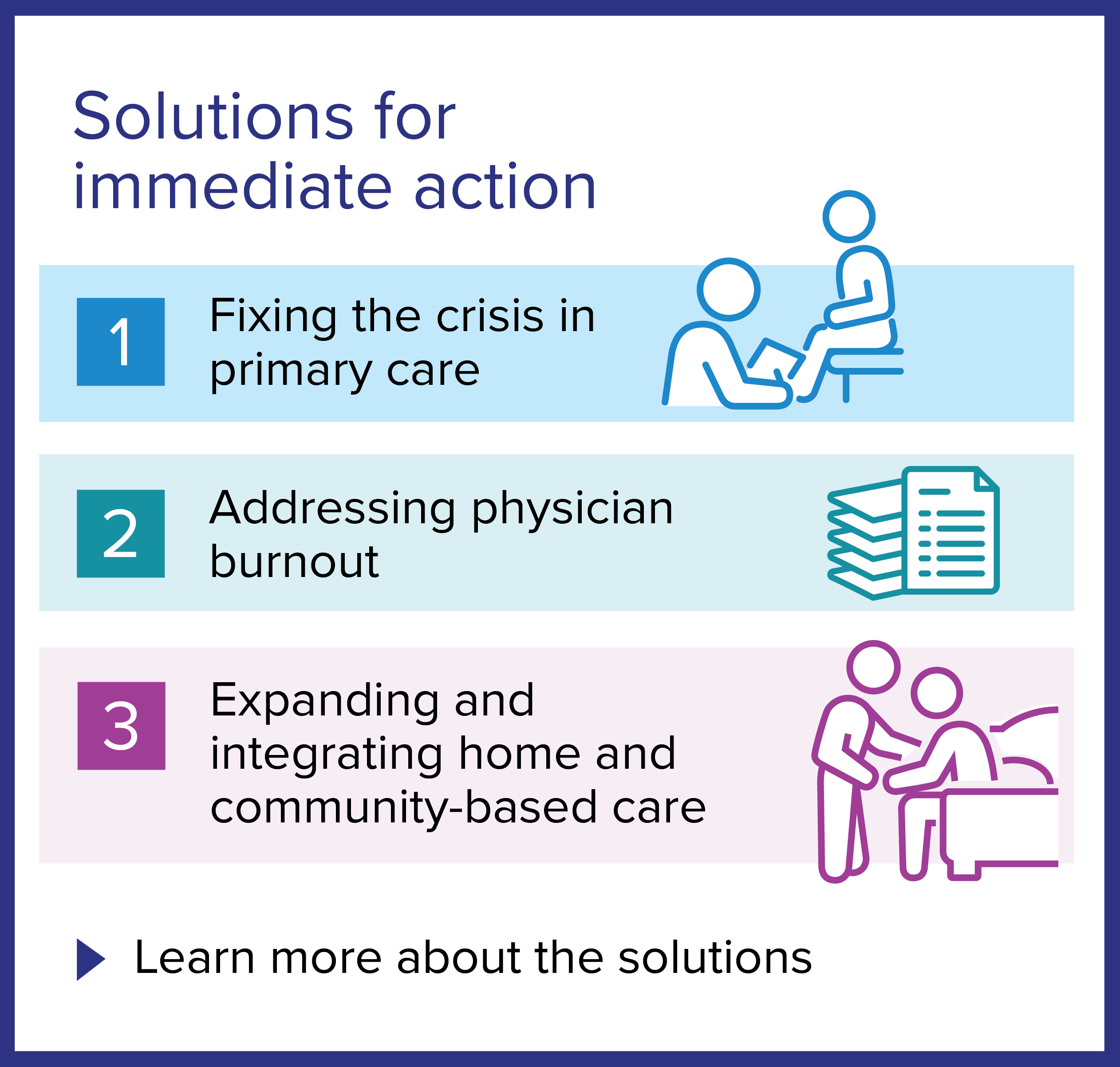Prescription for Ontario: 2023 progress report
Where do we stand 18 months later?
Doctors’ expertise in finding solutions to fix our system is being recognized. Our Prescription is having an impact.
- Wait times are being addressed by moving less complex procedures to community clinics
- Palliative care is being expanded to open up more hospice beds
- Patients will have more access to doctors through a practice-ready assessment program for those trained overseas
- Ontarians struggling with mental health and addiction conditions will have more support
These successes on behalf of Ontarians reflect physicians’ dedication to improving health care.
Together, we met face-to-face with cabinet ministers and more than 40 MPPs from across all parties. We have advocated at joint tables, presented to legislative committees, collaborated on working groups, and submitted proposals to strengthen and guide many government initiatives.
Read about the progress report.Read the news release.
Read the Ontario Medical Review story.
“The OMA’s Prescription for northern Ontario was one of the most impactful things to happen to NOSM University. It has brought much-needed media attention to health-care challenges in the north and is helping us address health inequity across our region. As a result, we are receiving significant expansion of our medical education programs” — Dr. Sarita Verma, president, vice-chancellor and dean of NOSM University.
Tracking government action
Despite progress, there is more to do
Attention has been paid to each of the five main pillars in the OMA’s 2021 Prescription for Ontario but there remains more to do — for example, there is a crisis in primary care and burnout is at an all-time high.


Problem
We know that up to 22 million health-care services that should have taken place during the pandemic did not. Sick patients do not have time to wait. At the same time, there is a primary care crisis with doctor shortages in many regions of the province and a recent study from INSPIRE Primary Health Care shows that 2.2 million Ontarians are without a family doctor.
Progress
Action has been taken by the government to reduce wait times, including the passage of Your Health Act, or Bill 60, which recognizes the credentials of health-care workers from other provinces and expands the role of community clinics in providing OHIP-covered surgeries and diagnostic tests. The province has also expanded medical school education, adding undergraduate seats and post-grad positions over five years, which will have an effect on the doctor shortage and wait times in the longer term. The government began investing in centralized surgical wait-list management to increase use of electronic referrals and support work to enable efficient tracking of surgical information.
More to do
As the provincial government shifts surgeries from hospitals to community clinics, details still need to be worked out, such as funding, human resources, quality of care and how to safely move procedures to day-surgery settings. To tackle this, we recommend that the government create an implementation committee, including clinical experts from medicine and nursing, hospital and regulatory partners and representatives from urban and rural communities and marginalized groups.
While the OMA welcomed the government’s commitment to assess up to 50 internationally trained physicians, we encourage the government to move faster while assessing even more.
“The health system needs to facilitate local and regional innovation to ensure the needs of patients are met. Doctors, as quarterbacks of patient care, must be involved in decision-making and the direction of patient care. For example, training more anesthesia assistants will allow the expansion of the already-existing anesthesia care team model to more hospitals. Ideas like this would save money and be a more efficient use of human resources” — Dr. Rohit Kumar, chair, Ontario’s Anesthesiologists, Mississauga, Ont.
A centralized intake and referral system should be managed by Ontario Health and implemented in collaboration with Ontario Health Teams, hospitals, community-based surgery and diagnostic clinics, specialists and primary care practices to ensure equitable and timely access. It should be created with strong physician involvement to help build a solution that works for patients and physicians. Funds will need to be set aside to cover this.
A government-wide effort involving multiple provincial ministries is required to “let doctors be doctors,” by moving expediently to reduce the burden of forms, red tape and administrative burden on day-to-day practice. While the government has made significant progress in addressing wait times, we will continue advocating for our recommendations to be fully implemented.


Problem
More than one million Ontarians experience mental health and addiction challenges every year and that number only grew as the impacts of the pandemic became more apparent. There must be greater accessibility to affordable and publicly funded services in the community so everyone can get the help they need.
Progress
The provincial government is investing more in mental health and addiction services, and targeting equity-deserving populations such as youth, post-secondary students, health workers and Indigenous Peoples in northern Ontario and rural areas. The Ontario government’s recent announcement on interprofessional care teams can help address mental health and addiction needs in the community.
More to do
Ontarians with moderate to severe mental health conditions do not have access to the care they need in the community. With nowhere else to go, many of these patients turn to their family doctors, further contributing to the crisis in primary care. The government should enhance family doctors’ capacity to care for these patients by funding and establishing interprofessional care teams with the necessary expertise to care for these patients. Only about one in four primary care providers has access to multidisciplinary team support for their patients, representing a significant care inequity.
The government should also continue to expand access to harm reduction services, such as supervised consumption sites and implement an Indigenous-led mental health and wellness strategy.
Some action has been taken on most of our recommendations to improve mental health and addiction care.


Problem
In 2019-20, there were 1.3 million hospital bed days Canada-wide used by patients stable enough to leave the hospital but who still required some level of care and there was no capacity available in a more appropriate setting. High-quality home and community care, including long-term care homes, reduces emergency department visits and hospital admissions, supports people at home, reduces wait times and avoids hundreds of millions of dollars in costs to the system each year.
“Family physicians need to be at the centre of team-based care” — Dr. David Barber, family physician, chair, Section on General and Family Practice, Kingston, Ont.
Progress
The province is investing in health-care teams and personal support workers to allow patients to remain and recover in their own homes. An expansion of long-term care beds and the necessary resources to operate additional beds will help those who need this level of daily medical care. At the same time, progress has been made in increasing the number of residential hospice beds in Ontario as well as expanded access to community palliative on-call programs, allowing hospice palliative patients to receive a holistic approach to care in their home or a home-like setting.
More to do
Providing long-term care homes and staff with the tools to manage acute medical needs will prevent unnecessary hospital transfers, freeing up hospital capacity, especially in the emergency department. All long-term care homes should be equipped with portable bladder scanners, access to mobile X-rays and ultrasound machines and funding should be available to provide the equipment and to train staff to administer IVs for fluids and medications.
"The ASO would like to thank Ontario’s doctors for your efficient, compassionate care and for being there for patients every step of the way. Dementia will be among the defining societal challenges of the coming decades. Nearly a third of all Ontarians have a close family member living with dementia, and nearly three-quarters are concerned about developing dementia themselves. This is a disease that affects all of us. We are grateful that the OMA has put an emphasis on mental health advocacy for health-care providers. Lack of care for caregivers often turns one patient into two patients" — Cathy Barrick, CEO, Alzheimer Society of Ontario.
Significant care gaps persist for those with life-limiting illnesses. Fixing this requires an integrated palliative approach to care at home and in community settings, addressing regional variations in access to palliative resources and providing consistent operational funding to hospices.
Navigating the system is difficult for patients and providers, but moving the province’s home-care co-ordinators to Ontario Health Teams can help patients access home and community care more quickly and easily. Further, it is imperative that all primary care providers, regardless of practice model or OHT affiliation, have the same access to care co-ordinators so that all patients can benefit from their key role. The government should also expand the care co-ordinator role to include support for navigating other parts of the health-care system.
Progress has been made on about half of our home and community care recommendations.


Problem
A strong public health system led by specially trained public health doctors is required to preserve health and prevent illness and prepare for the next pandemic. Public health offers a deep capacity that is not being leveraged for the benefit of the health-care system.
“As the Section on Psychiatry chair, it was encouraging to participate in stakeholder discussions for shaping the Prescription Progress Report 2023. There has been progress in setting up a framework for better patient and physician experiences during these trying times of navigating our health-care system. We walk with hope toward the work ahead” — Dr. Renata Villela, chair, Section on Psychiatry, Thornhill, Ont.
Progress
Ontario’s Pandemic and Emergency Preparedness Act expands measures to build a more resilient health-care system that is better able to respond to a crisis, including an expanded health workforce and shoring up domestic production of crucial supplies, such as personal protective equipment. Additional investment has been made in enhancing a co-ordinated approach to emergency management and adding capacity to plan, prepare, respond and recover from a public health crisis.
“To reduce the pressure on the system and family doctors, society needs to focus more on prevention. Conditions such as high blood pressure and diabetes, both of which can lead to serious life-altering complications, can often be prevented with a healthy lifestyle, and that takes more and better education from an early age” — Dr. Christine Seidler, family physician, South River, Ont.
More to do
Ontarians deserve a strong and connected public health and health promotion system. The Ontario government can make this a reality by appropriately funding local public health units and investing in systems so that we can better collect, analyze, share and use information in more thorough and timely ways. Before considering any changes, Ontario’s doctors also call on the government to carry out an independent and unbiased review of Ontario’s public health system — including its strengths and weaknesses during pandemic and non-pandemic times.
The government has taken action on only three of 11 of our recommendations.


Problem
Patients do better when they have connected care through a team of care providers, including family doctors, nurses, dietitians and physiotherapists. However, not all practice models for family doctors are funded for the inclusion of other health-care professionals. For a team to work effectively, its members need to be able to share information through integrated digital systems. When this is in place, patients get better care and avoid having to repeat their story.
“As we review the progress made since the release of a Prescription for Ontario, it’s clear that the decision to transition toward Ontario Health Teams has brought about some positive changes, especially in southern Ontario. As some northern OHTs still look to unite and modernize, there is work to do to address the gap in access to primary care and home and community care services for northern, Indigenous and francophone communities. We commend the Ontario Medical Association for the work they have done to provide recommendations to address these gaps to help improve patient outcomes, co-ordination of care and digital health innovation in the province. We look forward to working with our council members and the Ontario government to ensure that all Ontarians have equal access to quality health care" — Hélène Lavictoire, co-chair, Ontario Chamber of Commerce’s Health Policy Committee.
Progress
There has been an expansion of Ontario Health Teams, or groups of providers who deliver comprehensive and co-ordinated care within a geographic area. In addition, spots have opened up for more doctors to join family health organizations, a team-based model of care in which physicians work together to deliver primary health care for their community. The Ontario government also recently announced that it will be creating new interprofessional care teams in communities with the greatest need to help bridge the gap in accessing interprofessional primary care for marginalized and unattached patients.
More to do
While the new and expanded teams are a welcome start, the crisis in primary care still needs to be addressed. The government should build on its progress in expanding and enhancing access to team-based care by providing funding and support to allow all family physicians, regardless of practice model or geography, to access interprofessional care teams. These teams include a combination of physicians, nurses, care co-ordinators and other health-care professionals.
“As the next generation of doctors, we appreciate the opportunity to provide input into the Prescription for Ontario. We are particularly committed to providing every Ontarian with a digitally linked health-care team, built around the family doctor and with reduced wait times to all the specialists” — Rhea Jangra, co-chair Day of Action Committee, Ontario Medical Students Association.
In Ontario, doctors, hospitals, labs, pharmacists and home- and community-care teams all use different digital medical records systems that do not speak to one another. Connecting these different systems would reduce the administrative burden — and subsequent risk of burnout — and free up time for patient care. Physicians need to be involved as key partners from the start in the procurement, design, implementation and ongoing optimization of digital health tools to ensure usability. Physicians also need comprehensive and ongoing training in these tools, starting in medical school, along with easily accessible and ongoing technical support.
Progress has been made on about two-thirds of our recommendations.


Problem
Since the release of the Prescription for Northern Ontario, the physician workforce shortage in northern Ontario has worsened. A joint analysis by Ontario Health and the Northern Ontario School of Medicine University estimates that as of June 2022, northern Ontario was short 364 full-time-equivalent physicians. Physical access to care and services is made more difficult by weather, travel and distance. Virtual care is limited by lack of high-speed internet and unreliable connectivity.
Progress
New programs have been launched and additional funding committed to get and keep more doctors locally and provide more mental health and addictions support.
“Physician workforce in northern Ontario is a key equity issue for communities in northern Ontario, both for the health of the people who live here and also for the economic future of the north” — Dr. Sarah Newbery, assistant dean of physician workforce strategy at NOSM University, Marathon, Ont.
More to do
The chronic doctor shortage in northern Ontario needs urgent attention. Northern Ontario has vacancies for more than 20 psychiatrists and communities are actively recruiting for more than 50 urban family physicians and more than 100 rural generalist physicians. Together, psychiatrists and family physicians provide most of the medical care of those with mental illness.
Medical students, residents and internationally trained physicians need supports to acquire the confidence they require in choosing northern and rural practice for the long-term. In addition, there remains a significant need to support the retention of physician clinical teachers across the north who will mentor and support new graduates and supervise internationally trained physicians entering the workforce from the new practice-ready assessment program.
Significant action on our recommendations is still required to close the health-care gaps in the north.

